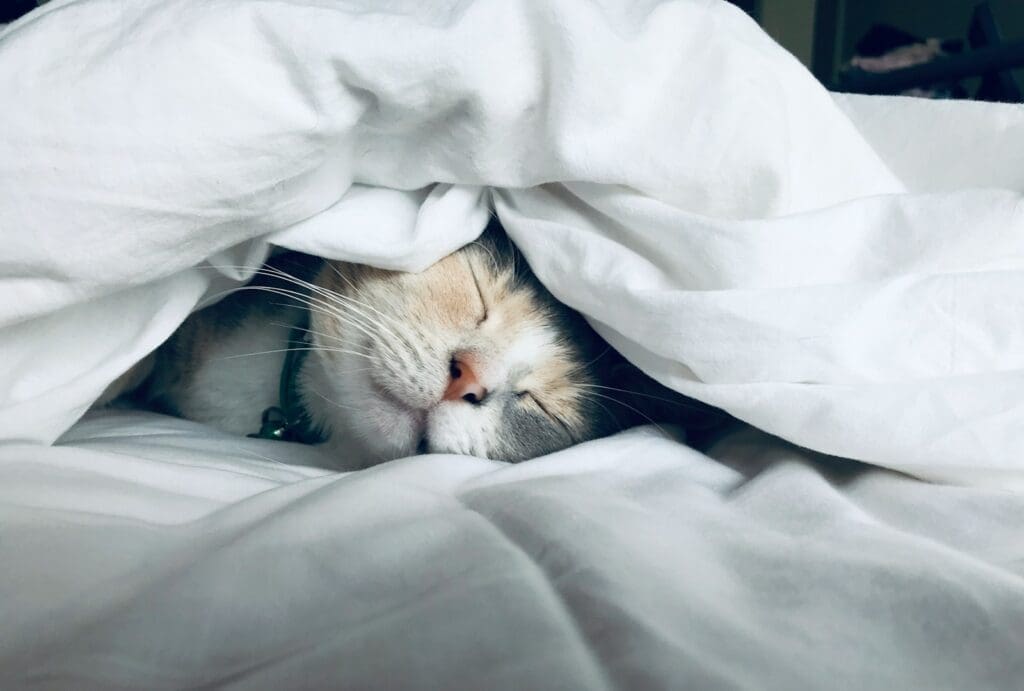Sleep Temperature is crucial to achieve a restful night’s sleep is crucial for overall health and well-being. However, hot temperatures can often disrupt our slumber, leaving us tossing and turning. Understanding the relationship between sleep and temperature can help us create an optimal sleeping environment. This article delves into the science behind sleep temperature regulation and offers practical tips to beat the heat at night for a more restful sleep.

The Science Behind Sleep and Temperature Regulation
The human body follows a circadian rhythm that dictates sleep-wake cycles, and temperature regulation is a key component of this biological process. As we approach bedtime, our core body temperature naturally lowers to signal that it’s time to sleep. This drop in temperature helps to initiate sleep and maintain it throughout the night.
Thermoregulation is controlled by the hypothalamus, a part of the brain that acts as an internal thermostat. When external temperatures are too high, this process can be disrupted, making it harder to fall and stay asleep. Understanding how our bodies manage temperature can help us create an environment that supports this natural cooling process for better sleep quality.
Temperature fluctuations during the night can also affect different stages of sleep, particularly REM sleep, which is crucial for cognitive functions such as memory and learning. Ensuring that your sleeping environment is conducive to maintaining an optimal body temperature can significantly improve overall sleep quality.
Ideal Bedtime Sleep Temperatures for Quality Sleep
Research suggests that the ideal room temperature for sleep falls between 60-67°F (15-19°C). This range allows the body’s core temperature to decrease naturally, promoting deeper and more restorative sleep. Keeping your bedroom within this range can help you fall asleep faster and reduce the likelihood of waking up during the night.
Individual preferences may vary slightly, but maintaining a cooler environment generally supports better sleep. It’s also important to consider factors such as humidity, which can affect how warm or cool a room feels. A dehumidifier can be a useful tool in maintaining comfort if you’re in a particularly humid area.
Experimenting with slight adjustments within the recommended temperature range can help you find the most comfortable setting for your personal needs. Remember, even minor changes in room temperature can have a significant impact on sleep quality.
How High Temperatures Affect Sleep Patterns
High temperatures can interfere with the body’s natural cooling process, making it difficult to fall asleep and stay asleep. As the body struggles to lower its core temperature, sleep onset can be delayed, leading to increased sleep latency and reduced sleep efficiency.
Heat can also disrupt the different stages of sleep, particularly REM sleep. This stage is essential for cognitive functions like problem-solving and emotional regulation, and disruptions can lead to grogginess and impaired cognitive performance the next day. High temperatures can lead to more fragmented sleep, resulting in frequent awakenings and reduced overall sleep quality.
Chronic exposure to a hot sleeping environment can contribute to long-term sleep issues such as insomnia. It can also lead to a cycle of sleep deprivation, which further impacts health, mood, and productivity. Taking proactive steps to manage nighttime temperatures is crucial for maintaining consistent and high-quality sleep.
Simple Tips to Cool Down Your Bedroom
One of the simplest ways to cool down your bedroom is to use fans or air conditioning units. Ceiling fans can help circulate air and create a cooling breeze, while portable fans can be positioned to target specific areas. Air conditioning units are more effective at lowering room temperatures but may require more energy.
Another effective method is to keep blinds or curtains closed during the day to block out sunlight, which can heat up your room. Opt for blackout curtains that can significantly reduce heat penetration. Additionally, keeping windows open during cooler parts of the day or night can promote natural air circulation and lower indoor temperatures.
Using natural materials such as cotton or bamboo for sheets and pillowcases can also help regulate sleep temperature. These fabrics are breathable and can wick away moisture, making them ideal for hot nights. Finally, consider using a cooling mattress pad or topper designed to help dissipate heat and keep you comfortable throughout the night.
The Role of Bedding in Regulating Sleep Temperature
Bedding plays a crucial role in maintaining an optimal sleep temperature. Natural materials like cotton, linen, and bamboo are breathable and moisture-wicking, making them ideal choices for hot nights. These materials help to facilitate air circulation and reduce heat retention, promoting a cooler sleeping environment.
Weighted blankets have gained popularity for their calming effects, but they can also trap heat. Opt for a lightweight version or one made from breathable fabrics to avoid overheating. Similarly, the choice of pillows can impact your sleep temperature. Gel-infused or ventilated pillows can help dissipate heat more effectively than traditional foam pillows.
Layering your bedding allows you to easily adjust your comfort level throughout the night. Use a light, breathable sheet as the base layer and add a lightweight blanket that can be easily removed if you get too warm. This flexibility can help you maintain a consistent and comfortable sleeping temperature.
Innovative Cooling Technologies for Better Sleep
Advancements in sleep technology have led to the development of innovative cooling solutions designed to enhance sleep quality. Cooling mattresses and mattress toppers, often infused with gel or designed with specialized cooling layers, help to draw heat away from the body and regulate sleep temperature throughout the night.
Smart beds equipped with temperature control features allow users to set their preferred sleeping temperatures. These beds can adjust the temperature automatically based on real-time data, ensuring that you remain comfortable all night long. Some models even offer dual-zone temperature controls, catering to the individual preferences of partners sharing the same bed.
Portable cooling devices such as bed fans and cooling pads offer targeted cooling solutions. These devices can be placed directly on the bed or incorporated into existing bedding to provide immediate relief from heat. As technology continues to advance, the options for maintaining an optimal sleep temperature are becoming more accessible and effective.
Importance of Air Circulation in Sleep Comfort
Proper air circulation is essential for maintaining a cool and comfortable sleeping environment. Stagnant air can exacerbate feelings of warmth and lead to discomfort, while good airflow helps to dissipate heat and promote a cooler atmosphere. Ceiling fans, portable fans, and open windows can all contribute to improved air circulation.
Using a ceiling fan set to rotate counterclockwise during the summer months can create a cooling breeze that helps to lower room temperature. Portable fans can be strategically placed to enhance airflow in specific areas of the bedroom, providing targeted cooling where it’s needed most.
In addition to mechanical solutions, natural ventilation can play a significant role in maintaining air circulation. Opening windows during cooler parts of the day or night allows fresh air to flow in and replace warm, stagnant air. This natural exchange can significantly improve the overall comfort of your sleeping environment.
Hydration and Its Impact on Nighttime Coolness
Staying hydrated is essential for regulating body temperature, especially during hot nights. Dehydration can impair the body’s ability to dissipate heat, making it harder to stay cool. Drinking adequate water throughout the day ensures that your body remains well-hydrated and better equipped to manage heat.
It’s important to strike a balance, as consuming large amounts of water right before bed can lead to frequent trips to the bathroom, disrupting sleep. Aim to maintain consistent hydration levels throughout the day and consider drinking a small glass of water before bedtime if needed.
Certain beverages, such as herbal teas, can also have a cooling effect on the body. Peppermint tea, for example, contains menthol, which can create a cooling sensation. Avoiding caffeine and alcohol before bedtime is crucial, as these substances can dehydrate the body and interfere with sleep quality.
Sleepwear Choices for Hot Summer Nights
Choosing the right sleepwear is essential for staying cool during hot summer nights. Lightweight, breathable fabrics such as cotton, linen, and bamboo are ideal choices. These materials allow for better air circulation and wick away moisture, helping to keep you cool and dry throughout the night.
Loose-fitting sleepwear is generally more comfortable in hot weather, as it allows for better airflow around the body. Tight or restrictive clothing can trap heat and exacerbate feelings of warmth. Opt for simple, minimalistic designs that prioritize comfort and breathability.
For those who prefer minimal clothing, sleeping in just underwear or even nude can be beneficial. This allows the body to cool more effectively by maximizing air exposure. However, personal comfort and modesty preferences should always be taken into consideration when selecting sleepwear.
Long-Term Solutions for Maintaining Cool Sleep Spaces
Investing in long-term solutions for maintaining a cool sleep space can significantly improve sleep quality over time. Insulating your home and installing energy-efficient windows can help to keep indoor temperatures stable and prevent excess heat from entering the bedroom.
Consider upgrading your HVAC system or installing a whole-house fan to enhance cooling efficiency. These systems can be more effective at regulating indoor temperatures compared to portable air conditioning units or fans. Regular maintenance of your cooling systems ensures optimal performance and longevity.
Landscaping can also play a role in maintaining a cool home environment. Planting shade trees or installing exterior shading devices can reduce heat absorption and lower indoor temperatures. By implementing these long-term solutions, you can create a consistently cool and comfortable sleeping environment that supports restful sleep.
Creating an optimal sleep environment is essential for achieving restful and restorative sleep, particularly during hot weather. By understanding the science behind sleep and temperature regulation and implementing practical cooling strategies, you can significantly improve your sleep quality. From adjusting your bedroom temperature to choosing the right sleepwear, every small change can contribute to a more comfortable and refreshing night’s sleep.


